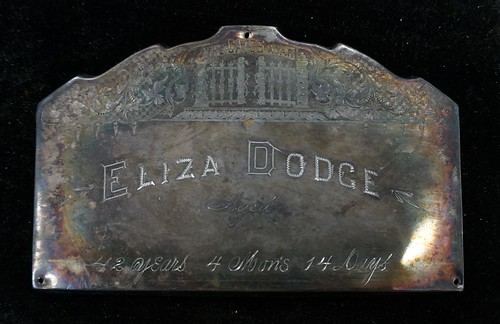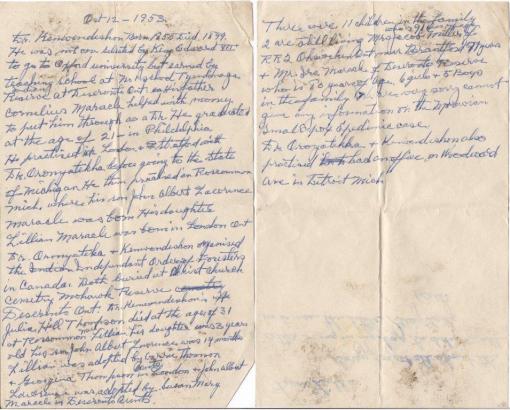Regular readers of this blog will probably be aware by now that here at Deseronto Archives we have fairly advanced views about opening up our collections and making as much of them as possible available online, both through this blog and through our Flickr account.

At the moment I am in Dundee, Scotland, at day one of a conference with the theme ‘Democratising or Privileging: the Future of Access to Archives‘. The programme is absolutely packed with talks about providing online access to archives and the role of digitization in making materials available to as wide an audience as possible.
Some of the most intriguing perspectives have come from users of archives. Dr Alan MacDonald spoke of his frustration about lack of published policies on what materials will be chosen for digitization and the lack of clarity over charging for access to online archives. (In the UK it is much more common for archives to charge genealogists for searching and reading records than it is in Canada.) He called for consistency in access to materials and for as much as possible to be open and free for all uses. A website designed for family historians, for example, may not be useful for other researchers if the only access to it is by name indexes.
Chris Paton is a professional genealogist and his pleas to archivists included a request for free wi-fi in archives, permission to take digital photos, longer opening hours and simpler user registration and photocopying policies. He also thought it was important for archives to make use of social media tools like Facebook and Twitter. Both Chris and Alan emphasized that although digitization is useful for accessibility, detailed online [item-level*] cataloguing is even more so, especially in a time of financial constraints for researchers (and everyone else!), although they both recognized that this is much harder to get funding for than ‘sexy’ digital imaging projects.
There is a strong Canadian contingent at this conference and Sara Allain from the University of Toronto Scarborough gave an interesting analysis of what she termed the ‘Digitization Rhetoric’ currently being advanced at Library and Archives Canada as the solution to the problem of access to materials there. Jenny Seeman of Memorial University of Newfoundland also looked at digitization, wondering about whether selectively digitizing a collection unfairly privileges one narrative about its contents over others, using the case of the Dr. Cluny MacPherson collection as her example.
Professor Wendy Duff of the University of Toronto talked about social media use in archives and ways of using elements of gaming theory to encourage public engagement with archival material online. I particularly liked the mental picture of online archives as rhizomes, providing multiple entry points to the material and different paths through it, which would vary from user to user. She also described archivists as walking finding aids, a point also echoed by Alan MacDonald, who agreed that the knowledge of archivists is priceless, and that it is hard to replicate that in online resources.
All in all, a fascinating day and plenty to think about!
Day 2
Many of the themes in the first day of the conference continued to be mentioned during the second. The difficulty of balancing public demand for materials with the cost of digitizing them came through loud and clear from representatives of the National Records of Scotland. Historian Professor Allan MacInnes gave an intriguing analysis of archival managers in relation to Calvanistic theology. According to Allan, administrators of archives fall into categories of the Church Invisible, the Church Visible and Reprobates. I can’t remember the precise details of the first two (they weren’t very complimentary!), but found myself warming towards his Reprobates: archivists “who believe that research and scholarship are more important than policy and procedure”. The issue of trust between archive managers and users was a strong theme of Allan’s keynote, along with a call for more collaboration between them.
More Canadians appeared in later sessions: Michael Moir of York University examined the ethical issues of access to confidential and sensitive information in personal papers. I liked Michael’s point that use of archival materials can be seen as a return on the investment of the institution in giving them shelf space: the cost of archival storage at York had been estimated at $80 a year for a box. Dr Jean Dryden reported on her research into archivists’ approaches to dealing with copyright restrictions. There’s a lot of caution in the community about putting things online and accidentally infringing copyright, so it was reassuring to hear from Jean that there have been no instances in North America of archives being sued for putting images online: any disputes have been settled amicably. I was interested to hear from Jean about the Smithsonian Archives of American Art’s approach, where entire collections are being digitized on the basis that “access trumps everything”.
François Cartier gave a thorough overview of recent developments at Library and Archives Canada, with a strong call for archivists to be part of the policy-making processes at their institutions. He quoted Carl Sagan: “extraordinary claims require extraordinary evidence” and Christopher Hitchens: “that which can be asserted without evidence, can be dismissed without evidence” as important principles to remember in response to claims made in the name of the modernization agenda at LAC.
Dr Cathryn Spence of the University of Guelph talked about her research on wills of women in the late sixteenth century. She had to pay for printouts of these (digitized) records in Scotland (and actually ended up asking her parents to get some of them for her as a Christmas present!). Other parts of her research were undertaken in a relatively poorly-funded archives service: Edinburgh City Archives. Cathryn was full of praise for the staff of this small repository, with whom she built up an excellent and trusting working relationship in a way that is very difficult in the larger, impersonal surroundings of the National Records of Scotland. This echoed Allan MacInnes’s observations made earlier in the day. The worrying part about the situation in the City Archives is the reliance of researchers on the knowledge of one archivist. One thing I’m hoping to achieve by writing blog posts here is to avoid having everything I’ve learnt about Deseronto’s archives leaving the Archives when I do! (Not that I’m planning to, just yet…)
Dr Vivienne Dunstan gave us a valuable insight into the problems faced by researchers who are wheelchair users. She described herself as “a big fan of online catalogues”, the more detailed the better (continuing another of the previous day’s themes). It was pleasing to hear that Vivienne found many archive services were willing to be flexible in giving her access to materials above what might have been usually offered. This was something else Allan MacInnes had called for: flexibility over standard procedures, where that is appropriate.
All in all, the conference was extremely interesting. Calls for archival policies based on evidence, on collaboration and on user needs were the main themes of the two days. And judging from the users who spoke, detailed catalogues; online resources which are explorable in a range of ways; mutual respect between staff and users; and adaptable procedures were top of their list of requirements. Thanks to colleagues at the University of Dundee’s Centre for Archive and Information Studies for organizing a fascinating event!
There’s further coverage of the conference over at British GENES and Viv’s Academic Blog.
*Postscript: Chris didn’t actually say ‘item-level’ – he was talking about cataloguing in general. My apologies!











 A new accession takes us back almost one hundred years, to a time when the Rathbun family were still the most influential people in Deseronto. After the death of the Rathbun Company’s driving force, Edward Wilkes Rathbun, in 1903, his eldest son, Edward Walter Rathbun (1865-1940), took over as head of the company. He was also active in provincial and local politics: between 1905 and 1908
A new accession takes us back almost one hundred years, to a time when the Rathbun family were still the most influential people in Deseronto. After the death of the Rathbun Company’s driving force, Edward Wilkes Rathbun, in 1903, his eldest son, Edward Walter Rathbun (1865-1940), took over as head of the company. He was also active in provincial and local politics: between 1905 and 1908 








